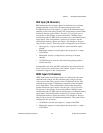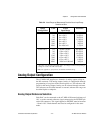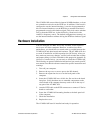
Chapter 2 Configuration and Installation
©
National Instruments Corporation 2-7 AT-MIO-16X User Manual
Interrupt and DMA Channel Selection
The base I/O address selection is the only resource on the AT-MIO-16X
board that must be set manually before the board is placed into the PC.
The interrupt level and DMA channels used by the AT-MIO-16X are
selected via registers in the AT-MIO-16X register set. The
AT-MIO-16X powers up with all interrupt and DMA requests disabled.
To use the interrupt capability of the AT-MIO-16X, an interrupt level
must first be selected via register programming, then the specific
interrupt mode must be enabled. The same method holds for DMA
channel selection. To use the DMA capability of the board, one or two
DMA channels must be selected through the appropriate register, then
the specific DMA mode must be enabled. It is possible to have interrupt
and DMA resources concurrently enabled.
The interrupt lines supported by the AT-MIO-16X hardware are IRQ3,
IRQ4, IRQ5, IRQ7, IRQ10, IRQ11, IRQ12, and IRQ15. The DMA
channels supported are Channels 0 through 3, and Channels 5
through 7. If you use the AT-MIO-16X in an AT-type computer, you
should only use DMA Channels 5 through 7 because these are the only
16-bit channels available. If you use the board in an EISA computer, all
channels are capable of 16-bit transfers and you can use them. The
AT-MIO-16X does not use and cannot be configured to use the 8-bit
DMA Channels 0 through 3 on the PC I/O channel for 16-bit transfers.
Analog Input Configuration
The analog input section of the AT-MIO-16X is software configurable.
You can select different analog input configurations by programming
the appropriate register in the AT-MIO-16X register set. The following
paragraphs describe in detail each of the analog input categories.
Input Mode
The AT-MIO-16X offers three different input modesSE) input,
referenced single-ended (RSE) input, and differential (DIFF) input.
The single-ended input configurations use up to 16 channels. The
DIFF input configuration uses up to eight channels. Input modes are
programmed on a per channel basis for multimode scanning. For
example, the circuitry can be configured to effectively scan
12 channels, four differentially configured channels and eight
single-ended channels. The input configurations are described in
Table 2-3.


















